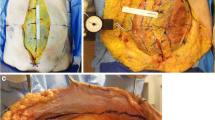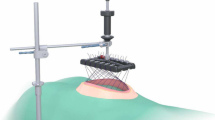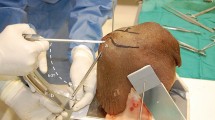Abstract
Purpose
The purpose of this study is to evaluate the tension at the aponeurotic edges after the undermining of the anterior rectus sheath associated with the classic components separation in cadavers.
Methods
Twenty fresh adult cadavers were placed supine and an incision in the anterior rectus sheath was done, thus exposing the posterior sheath. The two levels to be studied were marked 3 cm above and 2 cm below the umbilicus. An analogical dynamometer was used to measure the traction values, consecutively during four stages as follows: initial stage, no aponeurotic undermining; Stage 1, separation of the anterior rectus sheaths; Stage 2, after Stage 1 the external oblique aponeurosis were incised along the semilunaris and the external oblique muscles were undermined; Stage 3, after Stage 2 rectus muscles were completely separated from their posterior sheaths. Statistical analysis was done by Friedman’s analysis of variance (p < 0.05).
Results
There was a progressive and significant decrease in tension along the stages (Friedman’s analysis of variance, p < 0.001). Traction indexes were higher in the initial stage and became gradually lower along the other stages.
Conclusion
The undermining of the anterior rectus sheaths helps to decrease tension during the components separation technique.
Level of evidence
Level V, experimental study.






Similar content being viewed by others
References
Rohrich RJ, Lowe JB, Hackney FL, Bowman JL, Hobar PC (2000) An algorithm for abdominal wall reconstruction. Plast Reconstr Surg 105:202–216
Silveira RA, Nahas FX, Hochman B, Bazzano FC, Amorim CR, Ferreira LM (2011) Cadaver as an experimental a model for the study of midline incisional hernia. Acta Cir Bras 26:310–313
Mathes SJ, Steinwald PM, Foster RD, Hoffman WY, Anthony JP (2000) Complex abdominal wall reconstruction: a comparison of flap and mesh closure. Ann Surg 232:586–596
Nahas FX, Ishida J, Gemperli RF, Ferreira MC (1998) Abdominal wall closure after selective aponeurotic incision and undermining. Ann Plast Surg 41:606–617
Amorim CR, Nahas FX, Souza VT, Ely PB, Silveira RAB, Novo NF, Ferreira LM (2007) Tensile strength of the posterior and anterior layer of the rectus abdominis muscle sheath in cadavers. Acta Cir Bras 22:255–259
Barbosa MV, Nahas FX, Garcia EB, Ayaviri NA, Juliano Y, Ferreira LM (2007) Use of the anterior rectus sheath for abdominal wall reconstruction: a study in cadavers. Scand J Plast Reconstr Surg Hand Surg 41:273–277
Barbosa MV, Nahas FX, de Oliveira Filho RS, Ayaviri NA, Novo NF, Ferreira LM (2010) A variation in the component separation technique that preserves linea semilunaris: a study in cadavers and a clinical case. J Plast Reconstr Aesthet Surg 63:524–531
De Vries Reilingh TS, van Goor H, Rosman C, Bemelmans MH, de Jong D, van Nieuwenhoven EJ, van Engeland MI, Bleichrodt RP (2003) “Components separation technique” for the repair of large abdominal wall hernias. J Am Coll Surg 196:32–37
DiBello JN Jr, Moore JH Jr (1996) Sliding myofascial flap of the rectus abdominus muscles for the closure of recurrent ventral hernias. Plast Reconstr Surg 98:464–469
Ramirez OM, Ruas E, Dellon AL (1990) “Components separation” method for closure of abdominal-wall defects: an anatomic and clinical study. Plast Reconstr Surg 86:519–526
Vargo D (2004) Component separation in the management of the difficult abdominal wall. Am J Surg 188:633–637
Ennis LS, Young JS, Gampper TJ, Drake DB (2003) The “open-book” variation of component separation for repair of massive midline abdominal wall hernia. Am Surg 69:733–743
Losanoff JE, Richman BW, Jones JW (2002) Endoscopically assisted “component separation” method for abdominal wall reconstruction. J Am Coll Surg 195:288
Shestak KC, Edington HJ, Johnson RR (2000) The separation of anatomic components technique for the reconstruction of massive midline abdominal wall defects: anatomy, surgical technique, applications, and limitations revisited. Plast Reconstr Surg 105:731–738
Kuzbari R, Worseg AP, Tairych G, Deutinger M, Kuderna C, Metz V, Zauner-Dungl A, Holle J (1998) Sliding door technique for the repair of midline incisional hernias. Plast Reconstr Surg 101:1235–1242
Lindsey JT (2003) Abdominal wall partitioning (the accordion effect) for reconstruction of major defects: a retrospective review of 10 patients. Plast Reconstr Surg 112:477–485
Nahas FX, Ferreira LM (2003) Cadaver as an experimental model to study abdominal wall tension. Acta Cir Bras [serial online] 18 Special edition. Available from URL: http://www.scielo.br/acb
Howdieshell TR, Proctor CD, Sternberg E, Cué JI, Mondy JS, Hawkins ML (2004) Temporary abdominal closure followed by definitive abdominal wall reconstruction of the open abdomen. Am J Surg 188:301–306
Nahas FX, Kimura AK, Barbosa MV, Juliano Y, Ferreira LM (2011) Components separation technique with limited subcutaneous undermining: a cadaver study. Ann Plast Surg 67:303–308
Axer H, Keyserlingk DG, Prescher A (2001) Collagen fibers in linea alba and rectus sheaths. I. General scheme and morphological aspects. J Surg Res 96:127–134
Calvi EN, Nahas FX, Barbosa MV, Calil JA, Ihara SS, Silva Mde S, Franco MF, Ferreira LM (2012) An experimental model for the study of collagen fibers in skeletal muscle. Acta Cir Bras 27:681–686
Monkhouse WS, Khalique A (1986) Variations in the composition of the human rectus sheath: a study of the anterior abdominal wall. J Anat 145:61–66
van Geffen HJ, Simmermacher RK, Bosscha K, van der Werken C, Hillen B (2004) Anatomical considerations for surgery of the anterolateral abdominal wall. Hernia 8:93–97
van Geffen HJ, Simmermacher RK (2005) Incisional hernia repair: abdominoplasty, tissue expansion, and methods of augmentation. World J Surg 29:1080–1085
Amir A, Silfen R, Hauben DJ (2003) Rotation flap of the anterior rectus abdominis sheath for hernia prevention in TRAM breast reconstruction. Ann Plast Surg 50:207–211
Silveira RA, Nahas FX, Hochman B, Bazzano FC, Amorim CR, Juliano Y, Passos VM, Ferreira LM (2010) Mapping traction strength of the anterior rectus sheath in cadaver. Acta Cir Bras 25:347–349
Conflict of interest
The authors declare that they do not have any commercial interest in the subject of study and they also do not have any source of financial or material support.
Author information
Authors and Affiliations
Corresponding author
Rights and permissions
About this article
Cite this article
Barbosa, M.V.J., Ayaviri, N.A.M., Nahas, F.X. et al. Improving tension decrease in components separation technique. Hernia 18, 123–129 (2014). https://doi.org/10.1007/s10029-013-1094-7
Received:
Accepted:
Published:
Issue Date:
DOI: https://doi.org/10.1007/s10029-013-1094-7




